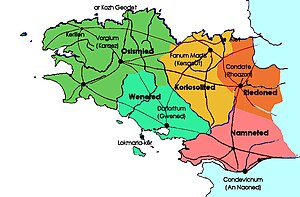Namnetes

The Namnetes were a
Roman period
.
Name
They are mentioned as Namnitō͂n (Ναμνιτῶν) by Polybius (2nd c. BC) and Strabo (early 1st c. AD),[1] Namnetes by Caesar (mid-1st c. BC) and Pliny (1st c. AD),[2] and as Namnē͂tai (Ναμνῆται) by Ptolemy (2nd c. AD).[3][4]
The etymology of the
Nemun-as in Lithuania.[5][6] According to Blanca María Prósper, however, "Namnetes is a locus desperatus of Celtic etymology, and to judge from its overall look it probably contains a negative particle. Ethnic names often have an exotic, for us hardly understandable, and usually more complex look than place or river names."[6]
Geography

Namnetes
The Namnetes dwelled between the lower
Their chief town was Condevincum, corresponding to the modern city of Nantes, and their chief port was known as Portus Nemetum.[7]
History
In the spring 56 BC, during the
Samnitae/Namnete Women's Island
According to
Poseidonios, there is an island in the Ocean near the outlet of the Loire river which was inhabited by the "women of the Samnitae," which is generally taken to be a mistake and actually refers to the "Namnitae" or Namnetes.[10] No man was ever allowed on the island and the women themselves sailed from it to have intercourse with men on the continent before returning there again. They also had the strange custom of unroofing their temple every year and roofing it again on the same day before sunset, each woman bringing her load to add to the roof. The woman whose load would fall out of her arms was rent to pieces by the rest, and they allegedly carried the pieces round the temple with the cry of "Ev-ah" in a frenetic manner.[11]
According to French archaeologist
Poseidonios.[12]
References
- ^ Polybius. Historíai, 34:10:6; Strabo. Geōgraphiká, 4:2:1.
- ^ Caesar. Commentarii de Bello Gallico, 3:9:10; Pliny. Naturalis Historia, 4:107.
- ^ Ptolemy. Geōgraphikḕ Hyphḗgēsis, 2:8:8
- ^ Falileyev 2010, s.v. Namnetes, Civitas Namnetum and Portunamnetu.
- ^ a b Delamarre 2003, pp. 231–232.
- ^ a b Prósper 2013–2014, p. 123.
- ^ a b c Lafond & Olshausen 2006.
- ^ Talbert 2000, Map 7: Aremorica, Map 14: Caesarodunum-Burdigala.
- ^ Julius Caesar, III, 14
- ^ The dichotomy Samnitoi-Namnitoi is also present in Ptolemy's Geography : he writes that the Namnitoi live "south of the Veneti" while the "Namnitoi" are far in the east of the Andecavi and the Cenomani.
- ^ Strabo, Geography, IV, 4, 6
- ^ Jean-Louis Brunaux. Les Druides. Des philosophes chez les barbares. Paris, Seuil, 2006, p. 241
Bibliography
- ISBN 9782877723695.
- Falileyev, Alexander (2010). Dictionary of Continental Celtic Place-names: A Celtic Companion to the Barrington Atlas of the Greek and Roman World. CMCS. ISBN 978-0955718236.
- Lafond, Yves; Olshausen, Eckart (2006). "Namnetae". Brill's New Pauly. .
- Prósper, Blanca María (2013–2014). "Time for Celtiberian dialectology: Celtiberian syllabic structure and the interpretation of the bronze tablet from Torrijo del Campo, Teruel (Spain)". Keltische Forschungen. 6: 109–148.
- ISBN 978-0691031699.

